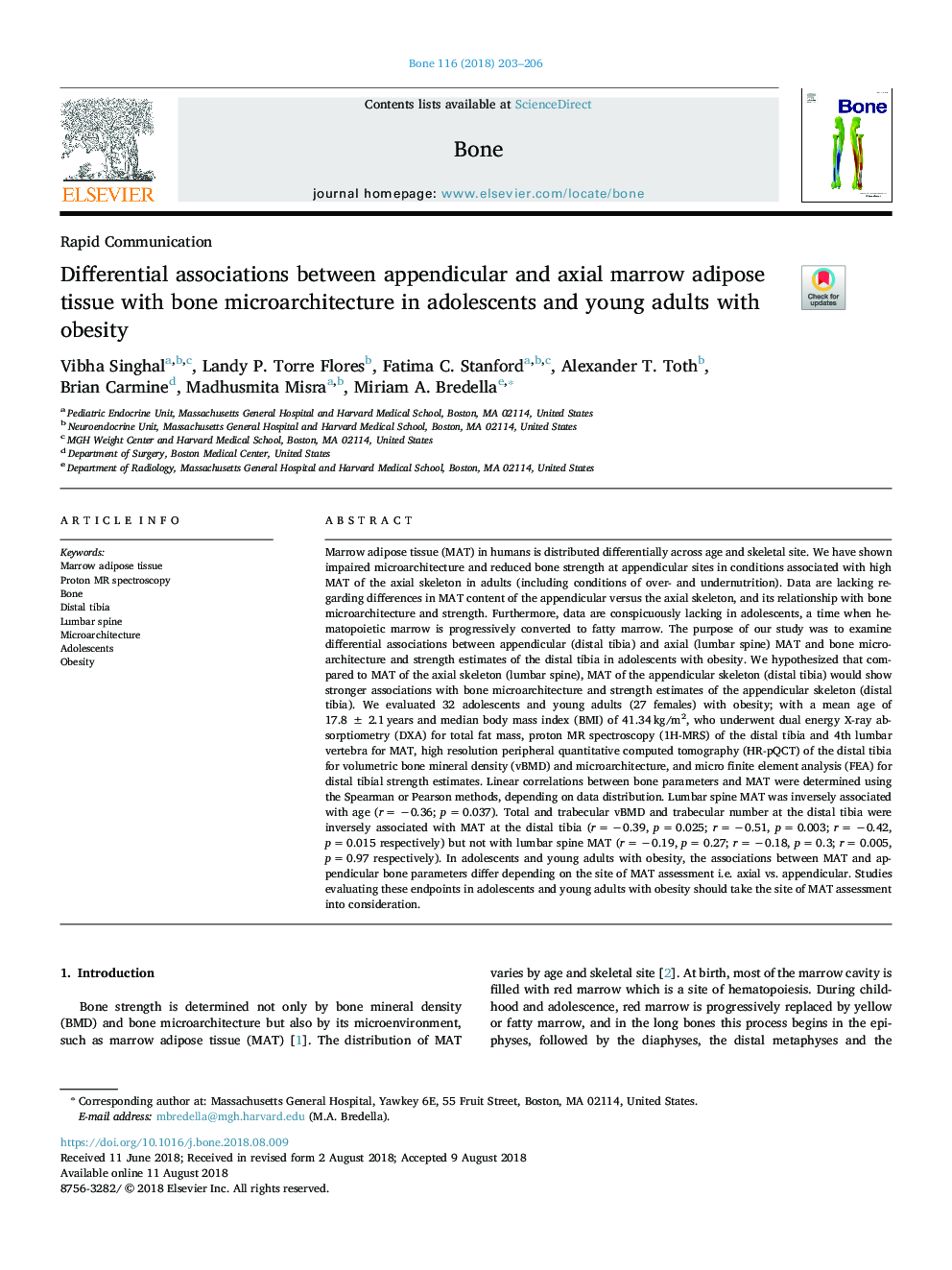| کد مقاله | کد نشریه | سال انتشار | مقاله انگلیسی | نسخه تمام متن |
|---|---|---|---|---|
| 8624769 | 1568104 | 2018 | 4 صفحه PDF | دانلود رایگان |
عنوان انگلیسی مقاله ISI
Differential associations between appendicular and axial marrow adipose tissue with bone microarchitecture in adolescents and young adults with obesity
ترجمه فارسی عنوان
ارتباط متقابل بین بافت چربی اپتوکال و محوری مغز استخوان در نوجوانان و جوانان با چاقی
دانلود مقاله + سفارش ترجمه
دانلود مقاله ISI انگلیسی
رایگان برای ایرانیان
کلمات کلیدی
موضوعات مرتبط
علوم زیستی و بیوفناوری
بیوشیمی، ژنتیک و زیست شناسی مولکولی
زیست شناسی تکاملی
چکیده انگلیسی
Marrow adipose tissue (MAT) in humans is distributed differentially across age and skeletal site. We have shown impaired microarchitecture and reduced bone strength at appendicular sites in conditions associated with high MAT of the axial skeleton in adults (including conditions of over- and undernutrition). Data are lacking regarding differences in MAT content of the appendicular versus the axial skeleton, and its relationship with bone microarchitecture and strength. Furthermore, data are conspicuously lacking in adolescents, a time when hematopoietic marrow is progressively converted to fatty marrow. The purpose of our study was to examine differential associations between appendicular (distal tibia) and axial (lumbar spine) MAT and bone microarchitecture and strength estimates of the distal tibia in adolescents with obesity. We hypothesized that compared to MAT of the axial skeleton (lumbar spine), MAT of the appendicular skeleton (distal tibia) would show stronger associations with bone microarchitecture and strength estimates of the appendicular skeleton (distal tibia). We evaluated 32 adolescents and young adults (27 females) with obesity; with a mean age of 17.8â¯Â±â¯2.1â¯years and median body mass index (BMI) of 41.34â¯kg/m2, who underwent dual energy X-ray absorptiometry (DXA) for total fat mass, proton MR spectroscopy (1H-MRS) of the distal tibia and 4th lumbar vertebra for MAT, high resolution peripheral quantitative computed tomography (HR-pQCT) of the distal tibia for volumetric bone mineral density (vBMD) and microarchitecture, and micro finite element analysis (FEA) for distal tibial strength estimates. Linear correlations between bone parameters and MAT were determined using the Spearman or Pearson methods, depending on data distribution. Lumbar spine MAT was inversely associated with age (râ¯=â¯â0.36; pâ¯=â¯0.037). Total and trabecular vBMD and trabecular number at the distal tibia were inversely associated with MAT at the distal tibia (râ¯=â¯â0.39, pâ¯=â¯0.025; râ¯=â¯â0.51, pâ¯=â¯0.003; râ¯=â¯â0.42, pâ¯=â¯0.015 respectively) but not with lumbar spine MAT (râ¯=â¯â0.19, pâ¯=â¯0.27; râ¯=â¯â0.18, pâ¯=â¯0.3; râ¯=â¯0.005, pâ¯=â¯0.97 respectively). In adolescents and young adults with obesity, the associations between MAT and appendicular bone parameters differ depending on the site of MAT assessment i.e. axial vs. appendicular. Studies evaluating these endpoints in adolescents and young adults with obesity should take the site of MAT assessment into consideration.
ناشر
Database: Elsevier - ScienceDirect (ساینس دایرکت)
Journal: Bone - Volume 116, November 2018, Pages 203-206
Journal: Bone - Volume 116, November 2018, Pages 203-206
نویسندگان
Vibha Singhal, Landy P. Torre Flores, Fatima C. Stanford, Alexander T. Toth, Brian Carmine, Madhusmita Misra, Miriam A. Bredella,
